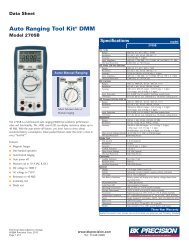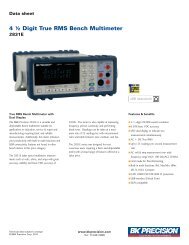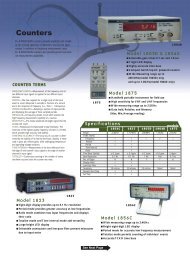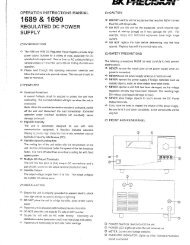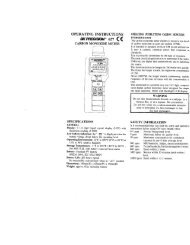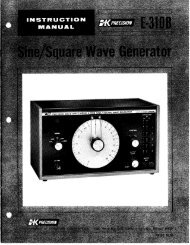2635 manual - BK Precision
2635 manual - BK Precision
2635 manual - BK Precision
Create successful ePaper yourself
Turn your PDF publications into a flip-book with our unique Google optimized e-Paper software.
Spectrum Analyzer Requirements<br />
Frequency Measurements<br />
To accurately display the frequency and amplitude of a signal on<br />
a spectrum analyzer, the analyzer itself must be properly<br />
calibrated. A spectrum analyzer properly designed for accurate<br />
frequency and amplitude measurements has to satisfy many<br />
requirements:<br />
1. Wide tuning range<br />
2. Wide frequency display range<br />
3. Stability<br />
4. Resolution<br />
5. Flat frequency response<br />
6. High sensitivity<br />
7. Low internal distortion<br />
The frequency scale can be scanned in three different modes<br />
full, per division, and zero scan. The full scan mode is used to<br />
locate signals because the widest frequency ranges are displayed<br />
in this mode. (Not all spectrum analyzers offer this mode).<br />
The per division mode is used to zoom-in on a particular signal.<br />
In per division, the center frequency of the display is set by the<br />
Tuning control and the scale factor is set by the Frequency Span<br />
or Scan Width control. In the zero scan mode, the analyzer acts<br />
as a fixed-tuned receiver with selectable bandwidths.<br />
Absolute frequency measurements are usually made from the<br />
spectrum analyzer tuning dial. Relative frequency measurements<br />
require a linear frequency scan. By measuring the relative<br />
separation of two signals on the display, the frequency difference<br />
can be determined.<br />
It is important that the spectrum analyzer be more stable than<br />
the signals being measured. The stability of the analyzer depends<br />
on the frequency stability of its local oscillators. Stability is usually<br />
characterized as either short term or long term. Residual FM is a<br />
measure of the short term stability which is usually specified in<br />
Hz peak-to-peak. Short term stability is also characterized by noise<br />
sidebands which are a measure of the analyzers spectral purity.<br />
Noise sidebands are specified in terms of dB down and Hz away<br />
from a carrier in a specific bandwidth. Long term stability is<br />
characterized by the frequency drift of the analyzers LOs.<br />
Frequency drift is a measure of how much the frequency changes<br />
during a specified time (i.e., Hz/min. or Hz/hr).<br />
32 Subject to change without notice







